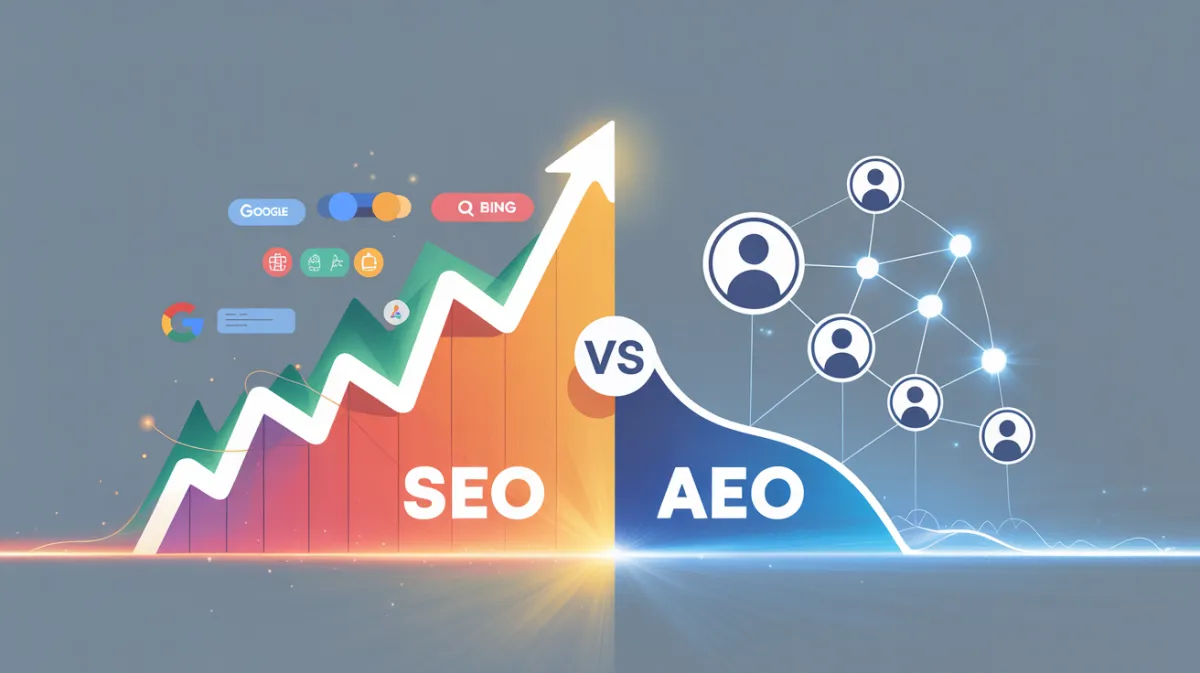
SEO vs AEO: What’s the Difference and Why It Matters in 2025
SEO vs AEO: What’s the Difference and Why It Matters in 2025
By Daisy Watkins
If SEO was the king of digital visibility for the past two decades, AEO (Answer Engine Optimization) is the rising power in 2025. Why? Because people don’t just “search” anymore—they ask.
Instead of typing “best marketing agency Las Vegas” into Google, a business owner now asks ChatGPT, “Who can help me with AEO visibility in Vegas?” And here’s the kicker: the engine doesn’t show a list of links. It gives a direct answer.
If your brand isn’t part of that answer, you don’t exist in that moment.
SEO vs AEO: A Side-by-Side Snapshot
SEO (Search Engine Optimization)AEO (Answer Engine Optimization)Optimizes for rankings in search resultsOptimizes to be chosen as the answerKeywords, backlinks, on-page signalsSchema, FAQs, structured Q&AWorks with human scanning behaviorWorks with AI parsing + conversational intentGoal: visibility on page oneGoal: visibility in AI answers
Think of SEO as a billboard on a busy street. AEO is the trusted concierge whispering directly into your prospect’s ear.
Why AEO Matters Now
74% of professionals already use AI to guide business decisions.
Google’s AI Overviews and platforms like Perplexity or ChatGPT are replacing traditional “search results.”
AI models don’t just reward who shouts the loudest—they reward clarity, authority, and structured answers.
This is where AEO shines. It makes your content:
Machine-readable (schema, JSON-LD, FAQs)
Conversational (short, clear answers)
Trustworthy (credentials, case studies, policies)
5 Fast Ways to Start with Answer Engine Optimization (AEO)

AI search is changing how people find businesses online. Instead of clicking through 10 blue links, buyers now ask ChatGPT, Gemini, Claude, or Perplexity and get one answer instantly.
The question is: Will that answer include your business—or your competitor’s?
That’s where Answer Engine Optimization (AEO) comes in. Unlike traditional SEO, which focuses on ranking in search engines, AEO makes your brand the source that AI engines recommend directly.
Here are five practical ways you can get started with AEO today—even if you’re not a technical expert.
1. Add Organization + FAQ Schema to Your Site
Schema is a type of structured data that helps AI and search engines “understand” your business.
Organization schema tells AI who you are, what you do, and how to contact you.
FAQ schema tells AI the specific questions you answer and makes them easy to extract.
Think of schema as labels on a library book—without them, your content may exist but be overlooked.
2. Build an “Answer Hub” Page for Each Service
Instead of scattering FAQs across your site, create a dedicated page per service that contains 15–20 real questions your customers ask.
For example, if you’re a law firm, an Answer Hub for “Estate Planning” might include questions like:
“How much does estate planning cost?”
“Do I need a lawyer for a living will?”
“What’s the difference between a will and a trust?”
This format helps AI engines pull your answers directly—and positions you as the go-to authority in your niche.
3. Reformat Blogs with Q&A Boxes and How-To Steps
Most blogs are written for people, not machines. But AI models need clear question → answer structures to extract and reuse your content.
Here’s how to reformat:
Add Q&A boxes inside your blogs (e.g., “What are the benefits of AEO?” → “The top three benefits are…”).
Break down instructions into step-by-step lists using “HowTo” schema when possible.
This makes your content not just readable—but answer-ready.
4. Publish Credentials + Testimonials (Trust Signals Matter)
AI engines care about credibility just as much as readers do. They’re trained to look for signals of authority:
Expert bios with credentials and headshots.
Client testimonials and case studies.
External proof like reviews, podcast mentions, or industry directory listings.
Remember: AI doesn’t just check your site—it cross-references the entire web. The more trust signals you provide, the higher your chances of being cited.
5. Track Your Site’s Presence in AI Overviews
Finally, don’t just “set and forget.” Test how visible your business is in AI engines:
Run manual checks: Ask ChatGPT, Gemini, Claude, and Perplexity the questions your buyers ask.
Track whether your brand is mentioned.
Pair this with analytics tools to monitor citations and visibility trends.
Your goal isn’t just clicks—it’s Answer Share: how often AI engines use your content as the source.
The Bottom Line
SEO still matters—but AEO is where the puck is going. Brands that get answer-ready now will own the next wave of digital visibility.
If your competitors show up in ChatGPT tomorrow and you don’t, the game is already over.
Ready to see if AI even knows you exist? Book your free AEO Readiness Audit with DW Conceptz today.
📌 Written by Daisy Watkins of DW Conceptz
